You are using an out of date browser. It may not display this or other websites correctly.
You should upgrade or use an alternative browser.
You should upgrade or use an alternative browser.
CBI diamonds - which of these are the best option?
- Thread starter Mikeeb123
- Start date
- Joined
- May 1, 2008
- Messages
- 3,563
Thanks @John Pollard - so which ones of the above diamonds would you go for?
You're welcome. Forum rules prevent me from pointing to a specific choice, but I'll relay a story from the weekend that might be useful context -
On Friday I showed Crafted by Infinity diamonds to a bright young lady and her gentleman in Dallas. I kept four diamonds under a cleaning cloth and asked her to place her hand flat on the table, fingers squeezed together. I placed the diamonds on her hand one by one (btw everyone should experience this - there's nothing quite like the feel of loose diamonds on your skin... ice ice baby).
Then I asked her to move her hand back and forth to enjoy the quartet of fireworks. She did this and they both commented on how all four sparkled identically. I gave that a few seconds then asked "Does anything on your hand offend you? Can I remove anything?" We laughed, because it was clear she was enjoying this. Then I had them take a tour to see them on her hand under different lighting. Once thoroughly viewed, I asked what stood out in terms of carat, color and clarity. She had noticed that one was larger, another was smaller and the two in the middle were about the same size (correct). What about clarity? She read that our diamonds would be eye-clean but put them to the test anyway, concluding there was no-difference. What about color? She had done her research, so she held her hand up to eye-level to view them from the side. But in that position, diamonds on her skin, it was hard to tell any difference (I agreed). And in the face-up view, she and her gentleman said there was no meaningful difference at all.
I asked if they were surprised to learn there were four different color grades represented on her hand. Yes, that was surprising... It was only when I moved them from her hand to a white color card, upside down to show them the descending tint from the side, that differences were clear (the range was 1.20 G - 1.60 J, all priced essentially the same). They were blown away that the 1.20 and 1.60 carat diamonds were the same price, with such negligible real-world difference to their eyes in casual viewing.
I have done this presentation many times. Some people perceive differences in warmth of color on the hand, but it's almost always more subtle than they expect. The end result is usually appreciable understanding for how size and sparkle make themselves apparent quickly - whereas a few grades difference in color or clarity might be rather negligible in real-world context.
So here is my suggestion: When you see diamonds, any diamonds, consider asking the jeweler to withhold details of weight, color and clarity at the start. Instead, have the diamonds placed together on your hand as I described. Take them on a 'tour' of different lighting conditions and let your eyes do the walking. All of the stats and clinical views can be done after that exercise. And I find the "play with them without knowing first" approach to be reliably educational and fun.
- Joined
- Jul 31, 2014
- Messages
- 20,110
You're welcome. Forum rules prevent me from pointing to a specific choice, but I'll relay a story from the weekend that might be useful context -
On Friday I showed Crafted by Infinity diamonds to a bright young lady and her gentleman in Dallas. I kept four diamonds under a cleaning cloth and asked her to place her hand flat on the table, fingers squeezed together. I placed the diamonds on her hand one by one (btw everyone should experience this - there's nothing quite like the feel of loose diamonds on your skin... ice ice baby).
Then I asked her to move her hand back and forth to enjoy the quartet of fireworks. She did this and they both commented on how all four sparkled identically. I gave that a few seconds then asked "Does anything on your hand offend you? Can I remove anything?" We laughed, because it was clear she was enjoying this. Then I had them take a tour to see them on her hand under different lighting. Once thoroughly viewed, I asked what stood out in terms of carat, color and clarity. She had noticed that one was larger, another was smaller and the two in the middle were about the same size (correct). What about clarity? She read that our diamonds would be eye-clean but put them to the test anyway, concluding there was no-difference. What about color? She had done her research, so she held her hand up to eye-level to view them from the side. But in that position, diamonds on her skin, it was hard to tell any difference (I agreed). And in the face-up view, she and her gentleman said there was no meaningful difference at all.
I asked if they were surprised to learn there were four different color grades represented on her hand. Yes, that was surprising... It was only when I moved them from her hand to a white color card, upside down to show them the descending tint from the side, that differences were clear (the range was 1.20 G - 1.60 J, all priced essentially the same). They were blown away that the 1.20 and 1.60 carat diamonds were the same price, with such negligible real-world difference to their eyes in casual viewing.
I have done this presentation many times. Some people perceive differences in warmth of color on the hand, but it's almost always more subtle than they expect. The end result is usually appreciable understanding for how size and sparkle make themselves apparent quickly - whereas a few grades difference in color or clarity might be rather negligible in real-world context.
So here is my suggestion: When you see diamonds, any diamonds, consider asking the jeweler to withhold details of weight, color and clarity at the start. Instead, have the diamonds placed together on your hand as I described. Take them on a 'tour' of different lighting conditions and let your eyes do the walking. All of the stats and clinical views can be done after that exercise. And I find the "play with them without knowing first" approach to be reliably educational and fun.
I want to pin this to the top of the forum and make it "required reading". SUCH AN IMPORTANT PIECE OF INFO!
- Joined
- Nov 7, 2004
- Messages
- 6,633
This is so true. I am happily waiting for a j CBI to be set. Truth be told I can tell it is slightly different tone than the H I used to have, but no sacrifice in performance (fire). For me, my order of importance is cut quality, clarity, carat, and color. So for me choosing the 77 point G would be a no-brainer.
It is great that you will be able to see them in person and compare them; that is the absolute best.
It is great that you will be able to see them in person and compare them; that is the absolute best.
- Joined
- Apr 23, 2018
- Messages
- 5,870
Actually @sledge, I would mention that the old rule of thumb about 2D crown height doesn't apply in our controlled production. I posted the below in another thread not too long ago, but it applies in this CBI-specific thread as well.
*
Crafted by Infinity’s fire proposition is the same, diamond to diamond.
We have a specific vision for each performance component. We also have the luxury of producing every diamond ourselves. To that end we're achieving 3D cutting goals where symbiosis between the collective facet groups notably outpaces some of those old rules of thumb.
This is a popular topic among our jewelers, and I’m going to share some of my training material here.
First…
What is fire? -vs- What is dispersion?
Many people refer to dispersion and fire interchangeably. But they are not the same.
To elaborate: If a strong dispersive fan passes over your eye and is wider than your pupil diameter you see a colored flash. If that dispersive fan is smaller than your pupil diameter the light is recombined and you see a white flash. If it's too small or weak you see nothing. In optimal cases, a single wide fan passing across your pupil may cause you to see a full suite of shifting chromatic colors, as on the left.
- Dispersion is caused by diamond material. It’s white light split into fans of rainbow colors and exiting the diamond.
- Fire is physiological. If a portion of a dispersive fan enters your pupil your brain sees a colored flash, or ‘fire.’ But if the whole fan enters your pupil you see a white flash, or possibly nothing.
So dispersion is not fire. Dispersion creates potential to perceive fire. But whether you see fire depends on the lighting, how the diamond was crafted and your own physiology.
Diamond fire origins and crown height
Beautiful antique diamonds are known for producing large, fluid colored flashes (usually at the expense of brightness). This cutting style evolved in an age when one rough diamond octahedron would be shaped into a single polished diamond. The most economical way of making that crystal attractive was to ‘brute’ the rough into a roundish shape – initially done by rubbing two diamonds cemented on sticks against one another. Once girdled, thick pavilion mains were polished on the bottom and extremely high crowns were fashioned on top. This let dispersive fans grow large as they passed through generous diamond material. Fire was the primary attribute and appeal of those cuts. In fact, the descriptor ‘fire’ comes from cutters in those days, who were maximizing the reflections of fire from the gas lamps under which they worked.
Economics and lighting changes
That all changed around 1900. The rotary saw allowed factories to get two diamonds from one rough crystal. Mechanical girdling evolved and jewelry store lighting shifted from gas lamps to incandescent, halogen and LED. Diamond industry economics and lighting advances saw crowns getting lower and lower & pavilion mains getting thinner and thinner. By 1980 the tables had turned - pun intended. From gas lamps and fire-priority to spotlighting schemes and brightness/fire/scint.
The proliferation of bright halogens and LEDs even stimulated a parade of cuts with additional facets, marketed as having ‘extra sparkle.’ True enough, those cuts sizzled like crazy when blasted with spotlights, but most had such reduced performance qualities in normal lighting that they didn’t survive for long. The Leo diamond is a notable exception.
Old 2D rule: Higher crown = More fire.
This rule of thumb has been passed down for over a century, and for good reason; All things equal, a diamond with a high crown and small table should produce more visible fire than a diamond with low crown and large table. It’s simple physics: More crown means more room in the diamond for dispersive fans to grow. Viola…
So it’s a good old rule. But it comes from a world of 2D proportions.
Crafted by Infinity 3D approach
We don’t rely on crown height for primary fire. Our proposition is fueled by 3D compound mirrors. It’s part of the consistent vision I mentioned; marrying brightness-intensity with fire-efficiency.
Brightness intensity is easy. Any factory can produce bright diamonds if they choose optimal angles and polish with even nominal consistency. Any production can also increase fire using leaps in 2D crown height.
But marrying top brightness intensity with fire-efficiency involves stepping into another world. It requires planning and 3D focus to keep internal reflections unbroken and of specific size. It also requires extra time, expense of weight and fine-tuning of diamond material. This is not graded by labs or mentioned on reports. But successfully applied, the result is larger internal mirror surfaces, and larger, more intense dispersive fans your pupils will see as colored flashes. "More Fire."
So there's your answer: Within our controlled production any minute differences in 2D proportions are negligible. The results come from all facets working together, which permits some variance as long as the greater goal is achieved.
In fact - and this shocks many of the jewelers I train - the classically considered ‘fire-facets’ actually take a backseat to some key minor facets in our proposition.
Visible implications
The performance characteristics have been consistently described here so I'll leave that to the community. I would just add that our goals for fire deliberately extend to low-lighting conditions where the observers’ pupils become more dilated. The reason I bring that up is because it's where you'll find the 3D compound mirror proposition notably outpaces 2D crown height in bringing fire.
Summary
Basic brightness continues to be numbers-predictable in round diamonds. It’s why the HCA is so simple but effective.
But as it relates to the question here, especially in such a narrow proportions range, achieving 3D symbiosis between collective facet groups can transcend some of the old rules of thumb.
That was a long read. I hope it's interesting and stimulating.
*
Original thread here.
https://www.pricescope.com/community/threads/cbi-fire.242606/#post-4388614
Thank you for clarifying @John Pollard. I appreciate your insight and technical insights.
All this said, I will retract my previous statements about the angles, etc as the CBI stones have been matched at a higher level that should essentially result in the same performance.
I'd have to disagree with sledge and say the 0.17mm size difference is most certainly noticeable in these diamonds, you're not doing a 8.xxmm comparison but a 5.xxmm. the relative difference is reasonably large.
Unfortunately @gm89uk I have to disagree with you still.
No doubt, percentage wise the 0.17mm difference is more on a 5mm stone vs an 8mm stone. No disagreement about that. Where we differ in opinion is that at the end of the day it's still 0.17mm which is a static distance that (most) humans can barely detect. And that unless compared side by side, you wouldn't be able to discern. In fact, if not shown side by side the difference is so small I think most people would not be aware there was a size difference.
So in this case the 0.17mm trumps percentages, IMO.
Of course, as @John Pollard eloquently pointed out below, this one particular customer he had over the weekend couldn't tell a difference between G-J, so maybe the OP won't discern E from G. In which case I would probably take the larger stone as it's cheaper than the E. No sense in paying for something you can't see. I just felt the OP *may* have a reasonable shot of seeing a color difference since they previously owned a D IF stone. I think it's less likely the size will be a determining factor since the difference is so small.
You're welcome. Forum rules prevent me from pointing to a specific choice, but I'll relay a story from the weekend that might be useful context -
On Friday I showed Crafted by Infinity diamonds to a bright young lady and her gentleman in Dallas. I kept four diamonds under a cleaning cloth and asked her to place her hand flat on the table, fingers squeezed together. I placed the diamonds on her hand one by one (btw everyone should experience this - there's nothing quite like the feel of loose diamonds on your skin... ice ice baby).
Then I asked her to move her hand back and forth to enjoy the quartet of fireworks. She did this and they both commented on how all four sparkled identically. I gave that a few seconds then asked "Does anything on your hand offend you? Can I remove anything?" We laughed, because it was clear she was enjoying this. Then I had them take a tour to see them on her hand under different lighting. Once thoroughly viewed, I asked what stood out in terms of carat, color and clarity. She had noticed that one was larger, another was smaller and the two in the middle were about the same size (correct). What about clarity? She read that our diamonds would be eye-clean but put them to the test anyway, concluding there was no-difference. What about color? She had done her research, so she held her hand up to eye-level to view them from the side. But in that position, diamonds on her skin, it was hard to tell any difference (I agreed). And in the face-up view, she and her gentleman said there was no meaningful difference at all.
I asked if they were surprised to learn there were four different color grades represented on her hand. Yes, that was surprising... It was only when I moved them from her hand to a white color card, upside down to show them the descending tint from the side, that differences were clear (the range was 1.20 G - 1.60 J, all priced essentially the same). They were blown away that the 1.20 and 1.60 carat diamonds were the same price, with such negligible real-world difference to their eyes in casual viewing.
I have done this presentation many times. Some people perceive differences in warmth of color on the hand, but it's almost always more subtle than they expect. The end result is usually appreciable understanding for how size and sparkle make themselves apparent quickly - whereas a few grades difference in color or clarity might be rather negligible in real-world context.
So here is my suggestion: When you see diamonds, any diamonds, consider asking the jeweler to withhold details of weight, color and clarity at the start. Instead, have the diamonds placed together on your hand as I described. Take them on a 'tour' of different lighting conditions and let your eyes do the walking. All of the stats and clinical views can be done after that exercise. And I find the "play with them without knowing first" approach to be reliably educational and fun.
I want to pin this to the top of the forum and make it "required reading". SUCH AN IMPORTANT PIECE OF INFO!
I second this!
- Joined
- Jul 12, 2004
- Messages
- 4,060
I third this! Have bought 5 CBIs now, and I still can't remember @John Pollard s
eloquent presentation. Oh, and I like CBI diamonds on my skin too, lol
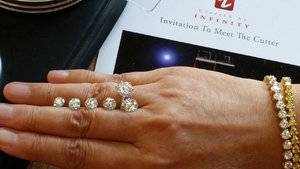
Which one is which?
eloquent presentation. Oh, and I like CBI diamonds on my skin too, lol

Which one is which?
icy_jade
Ideal_Rock
- Joined
- May 1, 2009
- Messages
- 6,131
Unfortunately @gm89uk I have to disagree with you still.
No doubt, percentage wise the 0.17mm difference is more on a 5mm stone vs an 8mm stone. No disagreement about that. Where we differ in opinion is that at the end of the day it's still 0.17mm which is a static distance that (most) humans can barely detect.
0.17mm difference is not barely detectable. I would say it’s immediately obvious to my untrained eye in a side by side comparison.
- Joined
- Jul 18, 2015
- Messages
- 4,084
That looks so decadently luxurious.I third this! Have bought 5 CBIs now, and I still can't remember @John Pollard s
eloquent presentation. Oh, and I like CBI diamonds on my skin too, lol
Which one is which?
On that 0.17mm thought, I'd like to share my experience from yesterday.
I walked into a very famous shop specialising in pearl jewelry and asked to see some 6.5mm pearl earrings as I'd been eyeing them for a while. The SA took some rosy white pearls out. While I was making my decision to purchase them, I asked to compare silver vs rosy overtones. She then proceeded to show me a silver white pair and placed them beside the rosy ones. Immediately, I said "hey they are bigger?" Despite both having the same price for 6.5mm. So I asked if they had vernier callipers. They did and she measured them in front of me. The rosy pair was 6.6mm and the silver pair was 6.75mm!
My point is, the 0.17mm difference is so immediately obvious even
- at 6.5mm base measurements (and yours is 5.5mm base so the 0.17mm will mean so much more)
- in pearls hence the difference in diamonds will be even more pronounced because of the light return
- more so because you are getting TOP TOP TOP light performance through your CBI.
And I can attest to this because I see clearly the difference between my CBI and non-CBI but super ideal stones!
@Mikeeb123 Are you going to Durhamrose? Here's wishing you have a wonderful experience getting your perfect ring!
I walked into a very famous shop specialising in pearl jewelry and asked to see some 6.5mm pearl earrings as I'd been eyeing them for a while. The SA took some rosy white pearls out. While I was making my decision to purchase them, I asked to compare silver vs rosy overtones. She then proceeded to show me a silver white pair and placed them beside the rosy ones. Immediately, I said "hey they are bigger?" Despite both having the same price for 6.5mm. So I asked if they had vernier callipers. They did and she measured them in front of me. The rosy pair was 6.6mm and the silver pair was 6.75mm!
My point is, the 0.17mm difference is so immediately obvious even
- at 6.5mm base measurements (and yours is 5.5mm base so the 0.17mm will mean so much more)
- in pearls hence the difference in diamonds will be even more pronounced because of the light return
- more so because you are getting TOP TOP TOP light performance through your CBI.
And I can attest to this because I see clearly the difference between my CBI and non-CBI but super ideal stones!
@Mikeeb123 Are you going to Durhamrose? Here's wishing you have a wonderful experience getting your perfect ring!
Last edited:
- Joined
- Apr 23, 2018
- Messages
- 5,870
0.17mm difference is not barely detectable. I would say it’s immediately obvious to my untrained eye in a side by side comparison.
Sorry @Mikeeb123, I don't recall your wife's exact finger size, but I think it was around a 5 IIRC. Rather than bicker over this, a picture is worth a thousand words. I disagree with @icy_jade about 1/150th of an inch (0.17mm) being of significance but here they are side by side so you can make your own determination.
Can I see a difference? Yes. Is it something I gasp and get giddy about? No. Is it something that is memorable (significant)? Not really. Do some people suffer from "mind size" like I suffer from "mind clean"? Absolutely, and that is what I think is really going on here. All in my opinion of course.
Based on actual dimensions of both stones.
https://www.diamdb.com/compare/0.71ct-round-5.71x5.73x3.52-vs-0.77ct-round-5.88x5.91x3.63/
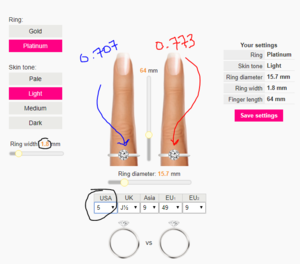
Sledge 0.17mm is just 1 dimension, in my experience, the eyes perceive the increased volume, rather than just the increased diameter, which is why I'm not a huge fan of the online comparison of diamond widths, the difference to me, is always more striking in real life.
Well technically it's a 0.17 x 0.18 x 0.11 mm difference when calculating volume. I suppose if we are in disagreement about 0.17mm difference, then you know we are in disagreement about you being able to see 0.11mm difference in vertical height as that is even less.
For the record, I know a difference exists. I know if comparing side by side, a slight difference can be seen. I'm just saying that difference is very, very minor and not memorable. I'm willing to bet that if @Mikeeb123 can detect (and be bothered) by that small of a difference than he will probably also be bothered (more so) by the jump from E to G in color.

icy_jade
Ideal_Rock
- Joined
- May 1, 2009
- Messages
- 6,131
You're welcome. Forum rules prevent me from pointing to a specific choice, but I'll relay a story from the weekend that might be useful context -
On Friday I showed Crafted by Infinity diamonds to a bright young lady and her gentleman in Dallas. I kept four diamonds under a cleaning cloth and asked her to place her hand flat on the table, fingers squeezed together. I placed the diamonds on her hand one by one (btw everyone should experience this - there's nothing quite like the feel of loose diamonds on your skin... ice ice baby).
Ok, this is going to be my new way to buy diamonds.
- Joined
- Apr 23, 2018
- Messages
- 5,870
@sledge have you seen unset diamonds of different sizes side by side in real life? I think you need to so you can appreciate what some of us are trying to tell you, just as you now understand color/warmth better after getting your stone.
Yes I have actually. On numerous occasions.
I'm not trying to be argumentative here, but I still disagree. I understand a 3D object will size different than a 2D object. I am also very familiar with scaling as I deal with it daily. While I can see a difference I stand by it's not significant.
FYI, attached are PDF's and images of a scale I custom created on my CAD program. I am including both image and PDF formats as the PDF you can print to scale and see exactly what we are talking about.
Original (actual scale - image may not be actual scale, but attached PDF is):
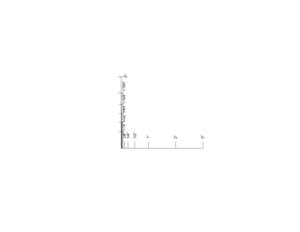
Modified to show only 1/150th with other dimensions (actual scale - same note applies about PDF/image):
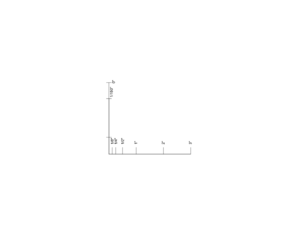
Blown up view to show close up views of lines forming various dimension points (not to scale):
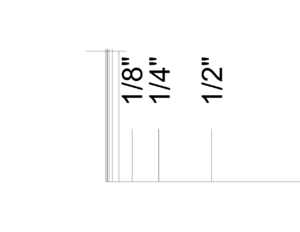
Attachments
- Joined
- Jan 16, 2018
- Messages
- 1,256
I'll have to agree with @sledge. And I'll give my own experience, as I think it is relevant here. The original diamond I ordered, and subsequently returned, was an AGS0 .78 G/VS1 that was 5.88-5.91mm in diameter. The second diamond that I kept is a GIA Ex .91 D/VS2 that is 6.22-6.23mm. That's a different of about .32mm. Both were in fairly similar platinum bezel settings. As for the size difference: Yes, it is there. Upon receiving the second diamond I could tell that it was slightly larger. But the key word here is slightly. Like, ever so slightly. Like, I-never-would've-noticed-it-in-real-life slightly. Sure, if the rings had been placed side by side (I unfortunately never got the chance to view them side by side), I probably would've been able to tell the difference in size upon close examination. But this is nearly DOUBLE the difference in diameter we're talking about in the OP's case (.32mm vs .17mm). At .17mm, I think I would have a seriously hard time differentiating between the two unless they were directly next to each other (like on the same finger).
Honestly, what was much, much more noticeable in my opinion was the difference in color. I could clearly see the yellow tinge in the G color in home and office lighting, even from the face-up position. The D color looks crisp and white 100% of the time. Again, I never got to compare them side by side, but judging by the difference I've seen in both, I'm 99% certain that if someone showed me the two diamonds in office lighting and asked me what was different about them, I would notice the difference in color before I noticed the difference in size.
This is my own experience with two well-cut H&A diamonds that I've spent A LOT of time staring at under different lighting conditions (the G color for a week or two, and the D color for quite a bit longer than that ). Every diamond is of course different, and everyone's ability to detect and be bothered by color is also different. So this is my experience for whatever it's worth. But I do think that, if the OP has spent a few years looking at a D color, they might notice a difference in a G.
). Every diamond is of course different, and everyone's ability to detect and be bothered by color is also different. So this is my experience for whatever it's worth. But I do think that, if the OP has spent a few years looking at a D color, they might notice a difference in a G.
My $0.02
Honestly, what was much, much more noticeable in my opinion was the difference in color. I could clearly see the yellow tinge in the G color in home and office lighting, even from the face-up position. The D color looks crisp and white 100% of the time. Again, I never got to compare them side by side, but judging by the difference I've seen in both, I'm 99% certain that if someone showed me the two diamonds in office lighting and asked me what was different about them, I would notice the difference in color before I noticed the difference in size.
This is my own experience with two well-cut H&A diamonds that I've spent A LOT of time staring at under different lighting conditions (the G color for a week or two, and the D color for quite a bit longer than that
My $0.02
- Joined
- Apr 23, 2018
- Messages
- 5,870
I'll have to agree with @sledge. And I'll give my own experience, as I think it is relevant here. The original diamond I ordered, and subsequently returned, was an AGS0 .78 G/VS1 that was 5.88-5.91mm in diameter. The second diamond that I kept is a GIA Ex .91 D/VS2 that is 6.22-6.23mm. That's a different of about .32mm. Both were in fairly similar platinum bezel settings. As for the size difference: Yes, it is there. Upon receiving the second diamond I could tell that it was slightly larger. But the key word here is slightly. Like, ever so slightly. Like, I-never-would've-noticed-it-in-real-life slightly. Sure, if the rings had been placed side by side (I unfortunately never got the chance to view them side by side), I probably would've been able to tell the difference in size upon close examination. But this is nearly DOUBLE the difference in diameter we're talking about in the OP's case (.32mm vs .17mm). At .17mm, I think I would have a seriously hard time differentiating between the two unless they were directly next to each other (like on the same finger).
Honestly, what was much, much more noticeable in my opinion was the difference in color. I could clearly see the yellow tinge in the G color in home and office lighting, even from the face-up position. The D color looks crisp and white 100% of the time. Again, I never got to compare them side by side, but judging by the difference I've seen in both, I'm 99% certain that if someone showed me the two diamonds in office lighting and asked me what was different about them, I would notice the difference in color before I noticed the difference in size.
This is my own experience with two well-cut H&A diamonds that I've spent A LOT of time staring at under different lighting conditions (the G color for a week or two, and the D color for quite a bit longer than that). Every diamond is of course different, and everyone's ability to detect and be bothered by color is also different. So this is my experience for whatever it's worth. But I do think that, if the OP has spent a few years looking at a D color, they might notice a difference in a G.
My $0.02
Thank you for sharing @TreeScientist. This was my point exactly.
As I recall the OP's wife had a slightly smaller D IF before the loss occurred. Insurance worked in their favor and now they only have awesome choices. As white as super ideals are, I truly believe staring at a D everyday has set an expectation others may not share.
One great thing. Regardless of the choice made, the OP wins.
I am excited to hear (and see) the final selection.
- Joined
- Apr 25, 2014
- Messages
- 8,225
So, @Mikeeb123 - how did it go?! 
The diamonds didn't get delivered in time! So going in next week to view.....
So, @Mikeeb123 - how did it go?!
- Joined
- Jan 11, 2006
- Messages
- 58,582
Just wanted to chime in late that the G stone by far would be my choice. The only reason to choose one of the others is if the person has only had D-E color diamonds before and cannot bear to go lower. I'd for sure choose the extra .17mm, and G VS1 is really my favorite color/clarity combo for quality and value. It's not like we are choosing G-J. In that case, I personally wouldn't choose J, but I could do the other three.
Lykame
Brilliant_Rock
- Joined
- Jun 1, 2018
- Messages
- 1,473
The diamonds didn't get delivered in time! So going in next week to view.....
I was thinking about this thread earlier... @Mikeeb123, if you're still around we would love to hear all about it!
- Joined
- Apr 23, 2018
- Messages
- 5,870
We went with the DVS1 in the end. We looked at all the diamonds without knowing which was which (as per advice above) and ruled the G out due to colour. It came down to the D and E and as the D was only £100 more we went with that one for comfort factor. Thanks for all your help everyone!

Congratulations!!
Very happy to hear you guys have made a choice. I am curious, can you and the Mrs stop staring at all the fire it makes? LOL. I'm sure the Mrs is through the roof to have a D VS1 CBI stone!
Would love to see some hand shots if you get a chance.
Also, just curious what you thought of the size difference between the 0.70D/E and 0.77G. I know we got rather lengthy about it. Was it something you noticed? And if so, did you consider it significant?
- Joined
- Jan 16, 2018
- Messages
- 1,256
Glad to hear you went ahead with a CBI! D/E is certainly my preferred color range as well, as you can definitely tell the difference between a D/E and a G. I think I would've made the same choice in your situation. For £100 more, why not go for the D? 
Would also be curious to hear about your perception of the size difference since you did the test blinded. You were obviously able to pick out the color in the G, but was the size difference very noticeable as well?
Would also be curious to hear about your perception of the size difference since you did the test blinded. You were obviously able to pick out the color in the G, but was the size difference very noticeable as well?
- Joined
- Feb 29, 2012
- Messages
- 12,388
blueMA
Brilliant_Rock
- Joined
- Aug 10, 2005
- Messages
- 1,257
Just by looking at the certs and angles, the D VS1 was my choice from the get go.
While general public in the majority can't even distinguish between CZs and diamonds, select people with trained eyes have distinct preference with diamond cut angles and color after years of exposure. For those who don't, size tend to trump with minor differences.
Nothing beats choosing diamond in person regardless.
While general public in the majority can't even distinguish between CZs and diamonds, select people with trained eyes have distinct preference with diamond cut angles and color after years of exposure. For those who don't, size tend to trump with minor differences.
Nothing beats choosing diamond in person regardless.
- Joined
- Apr 23, 2018
- Messages
- 5,870
Just by looking at the certs and angles, the D VS1 was my choice from the get go.
While general public in the majority can't even distinguish between CZs and diamonds, select people with trained eyes have distinct preference with diamond cut angles and color after years of exposure. For those who don't, size tend to trump with minor differences.
Nothing beats choosing diamond in person regardless.
Well said.
It's absolutely amazing at how people go all gaga over a size difference that is meaningless in the end.
blueMA
Brilliant_Rock
- Joined
- Aug 10, 2005
- Messages
- 1,257
a size difference that is meaningless
Well...not exactly meaningless. When appreciable difference in size could be perceived, that does matter since most viewers tend to notice that difference outright without taking a closer examination.
I'm sure we've all said "mine is bigger than yours" while growing up, sledge.
- Joined
- Apr 23, 2018
- Messages
- 5,870
Well...not exactly meaningless. When appreciable difference in size could be perceived, that does matter since most viewers tend to notice that difference outright without taking a closer examination.
I'm sure we've all said "mine is bigger than yours" while growing up, sledge.
I agree if there is an appreciable difference. I should have been more clear earlier. That is what I mrany earlier as the original debate in this thread was rather 0.15mm was appreciable or not.
Totally a moot point now.
Share:
How Are Diamonds Made? Natural vs Lab-Created Explained How Are Diamonds Made? Natural vs Lab-Created Explained - 08/05
How Are Diamonds Made? Natural vs Lab-Created Explained - 08/05

Top Wedding Ring Brands for Every Style and Budget
Top Wedding Ring Brands for Every Style and Budget - 08/05
Where to Buy Lab Grown Diamonds: Best Places Compared
Where to Buy Lab Grown Diamonds: Best Places Compared - 08/05

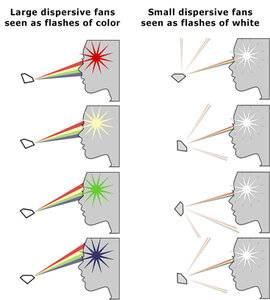
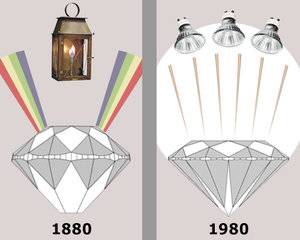
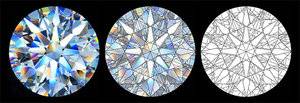
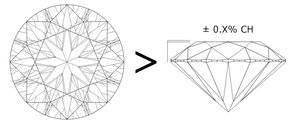

300x240.png)